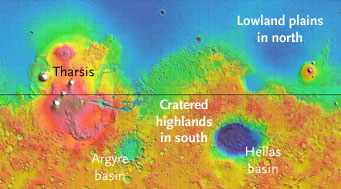When NASA's Viking orbiters completed the first comprehensive map of Mars in the late 1970s, scientists back on Earth puzzled over why the Red Planet appeared two-faced. Its southern hemisphere, dominated by heavily cratered highlands, stood in marked contrast to the flat, low-lying plains found in the north.

Mars exhibits a puzzling dichotomy: much of its southern hemisphere is ancient, heavily cratered highland terrain (colored orange and red in this cylindrical map of elevations), but its northern half is dominated by flat, low-lying plains (green and blue).
NASA / MOLA Team
In 1984, veteran researcher Don Wilhelms and up-and-comer Steven Squyres proposed that Mars had been struck a mighty blow early in its history — an impact so powerful that it blasted away much of the northern crust and left the planet with its Janus-like complexion.
Other scientists weren't so sure. For one thing, the resulting "crater," marked by the highland-lowland boundary that girds the globe, had an elliptical (not circular) outline. And the fit was particularly bad around the continent-size complex of towering volcanoes collectively called Tharsis. As an alternative, some researchers speculated that the young planet's interior had churned in an asymmetrical way that drove an enormous blob of hot magma upward on one side but not the other.
Yet Wilhelms and Squyres might have been right all along, as three papers in this week's Nature bolster the giant-impact scenario.
One tackles the poor fit of the highland-lowland boundary around Tharsis, which masks about 30% of it. A research trio led by Jeffrey Andrews-Hanna (MIT) used computer modeling, together with assumptions about the state of early Mars's rigid exterior (its lithosphere), to "remove" Tharsis. What remained was an elliptical boundary measuring about 6,600 by 5,300 miles (10,650 by 8,520 km) centered at 66°N, 151°W. (Andrews-Hanna offered a sneak peak of his team's result last March at a meeting of planetary scientists in Texas.)
A crater that size — larger than Asia and Europe combined — would rank as the largest impact in the solar system. But why wasn't it circular?
Margarita Marinova (Caltech) and two colleagues address that problem in the second Nature paper. Using three-dimensional modeling, they find that when impacts get this big, the spherical shape of Mars itself would have affected the outcome. And there's a "sweet spot" in the range of likely impact energies and collision angles that creates huge elliptical craters matching the Martian situation.
Marinova's team is betting that the impactor was 1,000 to 1,700 miles across and struck Mars a glancing blow (30° to 60°: from horizontal) at no more than 6 miles per second. Maverick planetoids this big must have been fairly common in the early solar system, and statistically they'd most likely strike other objects in this just range of angles.
Although not powerful enough to shatter the planet, the titanic blast would would have stripped away one hemisphere's worth of crust and smothered the other one with debris. The underlying mantle, superheated by the impact energy and exposed to space, would have flash-melted and later resolidified into new crust.
In fact, as Francis Nimmo (University of California, Santa Cruz) and three colleagues argue in the third paper, this Martian makeover should have resulted in a northern crust with a distinctly different composition than that in the southern highlands. It'd be a close match, they suggest, to a class of Martian meteorites called shergottites.
Interestingly, Nimmo's team concludes that the geophysical conditions for this mega-impact would have been just right about 100 million years after the planets formed — and, perhaps coincidentally, just about the time something the size of Mars slammed into Earth and created the Moon.
You can't access these articles unless you have a subscription to Nature, but abstracts are available here, here, and here.
 0
0
Comments
You must be logged in to post a comment.